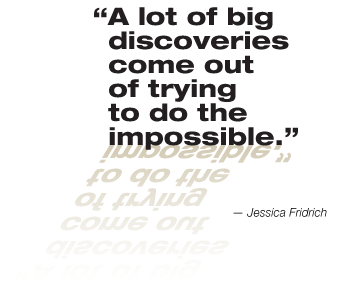page 1 | page 2

“They gave me a good background in physics and math, and I found I just like to crack things, to look at puzzles that seem impossible and find a way to crack them.”
In fact, Fridrich’s name is probably better known for her success in puzzle solving than for her academic research. In the early 1980s, soon after the Rubik’s Cube was introduced, it seized Fridrich’s attention even before it became a global craze.
“There was a silent challenge in the cube,” she said. “There was no system developed for solving it when it first came out. There was a silent challenge to design a system to solve it fast.”
So while most people were turning the cube over for hours, days and weeks at a time, gaining ground on one side only to lose on the others, Fridrich was developing a technique to accomplish the daunting task in seconds. Using the technique that is now known the world over as the Fridrich Method, Fridrich won the first Czechoslovakian speedcubing championship in 1982, and went on 21 years later to finish second in the 2003 Rubik’s Cube World Championship.
“When I was at my best, I routinely solved the cube in an average time of 17 seconds,” she said. “At that time, I was actively using more than 100 algorithms, but the minimum is 53 algorithms.”
The Fridrich Method remains one of the most-used speedcubing methods in the world. Last year, 18-year-old Ryan Patricio credited the technique with helping him win the 2007 U.S. Open Rubik’s Cube Championship in Chicago. He completed the puzzle in a mind-boggling 14.17 seconds.
Fridrich’s willful disregard for the accepted limits of possibility is embraced by her entire research group. Among others, the group includes Fridrich’s co-inventers Miroslav Goljan and Jan Lukas and post-doctoral assistant Mo Chen. Most recently, they developed and continue to refine the only technology that can match still digital images and digital video to the specific device that recorded them. Two patents on the technology are in the works.
“We are also extending the technology so we can identify the camera from images that were cropped and scaled at the same time,” Fridrich said. “You hit the limits of the technology faster because you have to do the search for the scaling and cropping, but you can still do a lot.”
The technology is now five to six times faster than it was in 2006, when word of its invention for use on still digital images attracted the interest of law-enforcement agencies the world over. In much the same way that telltale scratches allow forensics experts to match bullets to the gun that fired them, Fridrich’s digital fingerprinting technique can reliably link still and video digital images to the camera that shot them.
That’s because every digital imaging device ends up with distinctive marks on its sensors during manufacture, and Fridrich and her group have figured out how to detect and analyze the pixilated fingerprint left by each device on the images it records. Child pornographers, counterfeiters and movie pirates should be forewarned. The technology promises to put many more of them behind bars in the future than has been possible in the past.
Fridrich’s research team has even found a way to use the technology to find fingerprints in printed images, a development that grew out of another visit with apparent absurdity. “We were being filmed by a Swedish television crew, and the reporter asked, ‘So if you print out an image, can you get a fingerprint on it?’ We said ‘No, that would introduce too much distortion, with the printing and scanning process and the signature will not survive this.’ But we looked at each other and chuckled, like, ‘… what a silly question.’”
A week later, although the television crew was back in Sweden, that “silly” question was still knocking around in Fridrich’s head. So she went back to her team and asked, “If we can survive rescaling by 50 percent and jpeg compression, why can’t we survive printing and scanning?” In short order, the once absurd question became the vital seed from which sprang the group’s latest conference presentation, “Identifying Cameras from Printed Images.”
“It actually does work. It is easier to detect the signature in prints made at pharmacies or grocery stores than those you print in the lab or at home because the printing quality is much better in photo labs. We can identify the camera from regular postcard-size prints,” Fridrich said. “We were very surprised. It’s amazing. I would not have expected it in my wildest dreams. It’s not a big discovery, but people will be amazed. And we would not have come up with this on our own because we just presumed it impossible.”
The key, Fridrich said, is not to dismiss those stupid questions if you get them in your head. “You must nurture them and think about them,” she said. “You must have the time to sit around and brainstorm and wonder.”
Fridrich is fond of quoting Pablo Picasso, who once noted that “computers are useless because they only give us answers.”
“I think this is a great citation, and though he said that quite awhile ago when computers were not what they are today, it is still true,” she said.
Maybe in another 50 or 100 years artificial intelligence will change all that, and computers will start devising possibilityexpanding questions of their own. But for now, Fridrich thinks, it’s well worth our time and effort to strive to recognize and reap the true value of ill-informed questions. They might just offer us the potential to free ourselves from the self-imposed limitations of unexamined misbelief.
— Susan E. Barker
page 1 | page 2